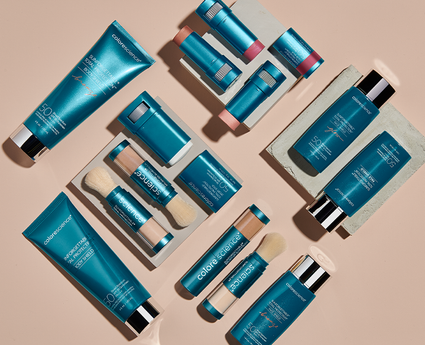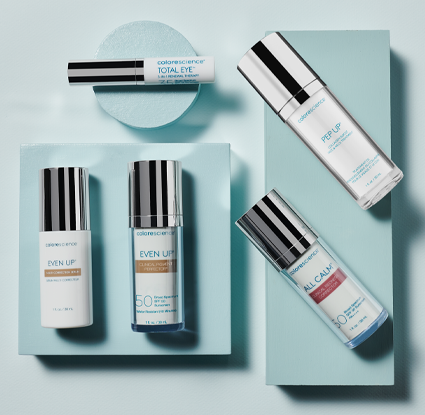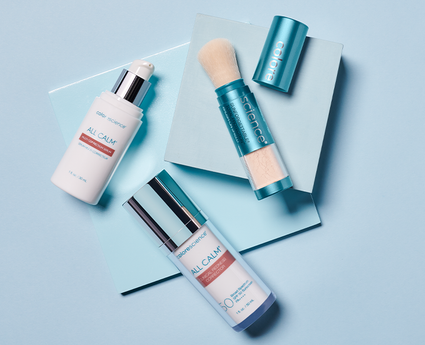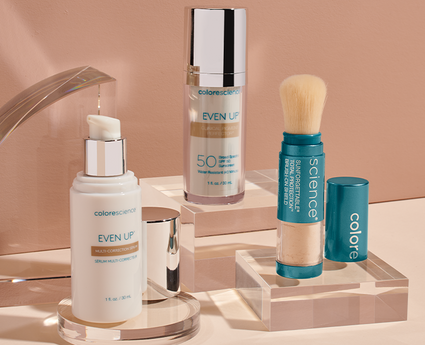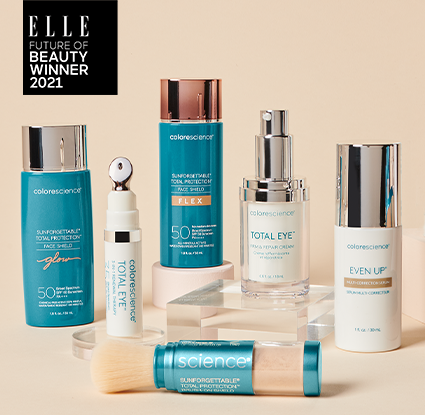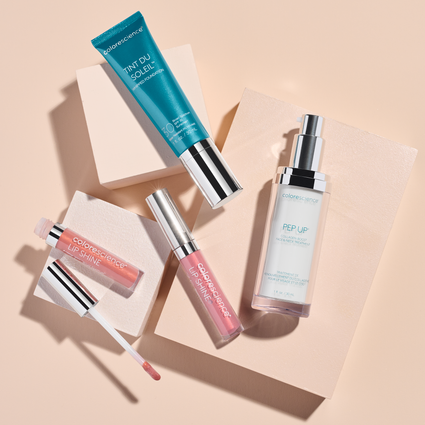PA ++++ in Sunscreen: What It Means & Why It Matters
When it comes to sun safety, knowledge is power.
Skin cancer statistics, sun safety awareness, and the rise in the rates of melanoma have many of us taking our sun care more seriously. If you’re looking for ways to keep your skin radiant and safe from the sun’s UV rays, give your sunscreen selection the due diligence it deserves.
With so many options, it’s important to look for sunscreen and mineral cosmetics that offer the protection you need for year-round essential skin care. But that can be easier said than done.
Sun protection ratings and labels are meant to inform and are designed to make it easier to choose the right products for your skin; unfortunately, the vast array of labels, testing stipulations, and regulations can be overwhelming. In recent years, you’ve likely seen a host of sunscreens with “PA++++” ratings.
Let’s decode this rating and help you find SPF 50, PA++++ sunscreen solutions that can keep you protected.
- Why Protecting Your Skin is Important
- Types of UV Rays
- How Sunscreen Works
- Sunscreen Rating Systems
- PA++++ Sunscreen Meaning
- Does PA++++ Sunscreen Provide Full UVA Protection?
- Recent Changes to PA++++ Rating System
- What is Broad Spectrum?
- What is the Best Measure of Sunscreen Effectiveness?
- Tips for Sun Protection
- How Do You Know If a Sunscreen Is PA++++?
- What Else to Look for on a PA++++ Sunscreen Label
- What Is the Best PA++++ Sunscreen?
- Beyond Sunscreen: PA++++ in Makeup
- Additional Innovation in Colorescience Sunscreen
- Protect Your Skin with Mineral PA++++ Sunscreen
Why Protecting Your Skin is Important
Before we delve into the mysteries of PA++++ rating systems, it’s essential to take a look at why sunscreen and sun protection are so important.
Whether you’re lying on a sunny beach or sledding in the snow, any time you’re outside—regardless of season—your skin is hit with ultraviolet radiation.
You’ve likely experienced a sunburn at least once in your life. Red, sensitive skin that’s swollen to the touch and heat are hallmarks of the average sunburn. If you took a look at your sunburned skin under a microscope, you’d spot damaged skin cells and blood vessels. Repeated sunburns lead to dry, discolored, leathery skin that bruises easily.
While sunburn is an immediate, visible danger of spending too much time in the sun, the damage goes much deeper.
Exposure to UV rays can lead to DNA damage in your skin cells, which can lead to skin cancer. Even if it takes quite a bit of time spent in the sun to tan or burn your skin, exposure to UV rays is still harmful.

Types of UV Rays
When it comes to ultraviolet radiation, there are three different categories:
- UVA rays: This type of radiation penetrates deep into the skin, and may lead to premature skin aging and cancer.
- UVB rays: This type of radiation is responsible for the color change in your skin after spending time outdoors—your tan or sunburn is a direct result of UVB rays.
- UVC rays: This type of radiation is completely absorbed by the earth’s atmosphere, and won’t reach your skin to cause damage. Luckily, this is one type of UV radiation you don’t need to worry about.
The ultimate goal of sunscreen is to shield your skin against UVA and UVB rays, both of which damage our skin and can cause skin cancer.
How Sunscreen Works
To understand the rating systems used on your favorite products, it’s important to know how sunscreen protects your skin.
Sunscreens can come in a variety of forms: lotions and mineral powders tend to be the most popular options. Sunscreen products are typically made up of a mix of inorganic and organic chemicals.
- Inorganic chemicals: This includes minerals like zinc oxide or titanium dioxide, which are used in sunscreen to act as a physical sunblock. These ingredients are adept at reflecting UV rays. If you’ve ever seen photos of lifeguards with white noses, you’ve seen these inorganic chemicals. With modern technology, companies have been able to make these particles smaller, so those familiar white stripes are seen less and less.
- Organic chemicals: This includes ingredients such as oxybenzone or avobenzone. These ingredients are able to absorb UV radiation, then release it from the body as heat.
Sunscreen Rating Systems
In the US, most people are familiar with the Sun Protection Factor (SPF) — your sunscreen or cosmetics's ability to shield your skin from UVB rays. The SPF number on your sunscreen indicates how long it takes for your skin to burn in the sunlight.
SPF doesn’t give you an exact measurement of time because everyone’s skin is different and burns at different rates. However, it does tell you that it will take x times longer for your sun to burn.

For instance, a product with SPF 20, like this bronzing face primer, would protect your skin from burning for twenty times longer than if you hadn’t worn any sunscreen.
While no sunscreen blocks 100% of UVB rays, SPF generally measures how well sunscreen protects you. The higher the SPF, the higher the percentage of protection offered. Does this mean you should opt for the highest SPF available? Not necessarily, but for your daily sunscreen, we typically recommend SPF 50 or higher.
To better demonstrate why, let’s break down SPF levels further:
- SPF 15 blocks 93%
- SPF 30 blocks 97%
- SPF 50 blocks 98%
- SPF 100 blocks 99%
As you can see, the difference in protection becomes minimal beyond SPF 30.
It’s important to remember that all sunscreen should be reapplied at least every two hours regardless of its SPF rating. If you’re going to be sweating or swimming, it’s recommended that you reapply even more frequently–every 40 to 80 minutes.
So, if SPF measures a product's ability to block UVB rays, what does PA++++ mean? Let’s take a look at SPF vs. PA++++ in sunscreen.
PA++++ Sunscreen Meaning
PA stands for Protection Grade of UVA, so PA+ ratings measure a product’s ability to block UVA rays.
You’ll spot PA ratings on a variety of sunscreens, healthy makeup, and skin care products.
Developed in Japan, the PA rating system was adapted from the Persistent Pigment Darkening (PPD) method. This test uses UVA radiation to cause a persistent darkening—tanning—of the skin to determine how long it takes for the skin to tan.
In theory, a sunscreen with a PPD rating of 10 should allow an individual to handle 10 times as much UVA exposure. However, PPD values can’t be measured precisely; because there’s no standardized system for evaluating PPD score, various rating systems are used to signal a product’s UVA protection strength.
PPD doesn’t indicate the exact amount of UVA protection a product provides; instead, this test is converted into a country or region’s scoring system.
Only certain countries utilize UVA testing, including Japan, the United Kingdom, Germany, the United States, and Australia. In Japan, PPD results are grouped and simplified into PA measurements.
These conversions go as follows:
- If a product’s PPD = 2 to 4, PA = PA+
- If a product’s PPD = 4 to 8, PA = PA++
- If a product’s PPD = 8 to 16, PA = PA+++
- If a product’s PPD = 16 or higher, PA = PA++++
It’s important to note that not all countries use the same ratings as PPD isn’t standardized.
Ultimately, PA+ means you’ll have some protection from UVA rays, with more plusses indicating a higher level of protection. Currently, the highest level of protection you can get from UVA rays is PA++++.
Because of the way PA sunscreens are categorized, it can be difficult to determine the difference in sun protection; for example, a sunscreen with a PPD of 20 and a sunscreen with a PPD of 40 could both be rated as PA+++ or PA++++, but there's no way to tell which one offers superior protection.
Additionally, there’s no way to discern between the ranges of PPD, so it’s safer to assume that it protects at the lowest PPD. For instance, a sunscreen with PA++++ has a PPD of 16 or higher, but you should assume that it protects at 16. This means that you’re protected 16 times more than you would be without the product.

Here’s an easy guide when shopping for sunscreens and cosmetics that utilize the PA++++ rating: the more plus signs on your product, the better.
Does PA++++ Sunscreen Provide Full UVA Coverage?
While SPF 50 and PA++++ sunscreen offer strong protection against UVB and UVA rays, remember that no sunscreen provides complete protection from the sun. PA++++ is the highest rating for UVA protection, but it doesn’t guarantee total blockage.
Various factors influence the impact of UVA rays on your skin, such as:
- Sunscreen formulation
- How often you reapply
- Your individual skin type
While PA++++ indicates high UVA defense, achieving optimal protection requires proper application and consistent reapplication—especially during prolonged sun exposure.
Recent Changes to the PA ++++ Rating System
As mentioned, Japan was the first country to start using the PA rating system. It was upgraded to PA ++++ in 2013, with non-Japanese brands following suit in recent years. Unfortunately, not all countries have upgraded to the new rating system and still consider PA+++ as the highest level of UVA protection.
What is Broad Spectrum?
PA++++ sunscreen, meaning it protects you 16 times more than having no sunscreen, only measures UVA rays. On the other hand, SPF only measures UVB rays. Both can lead to premature aging and melanoma, so it’s crucial to determine your level of protection from both UVA and UVB rays when choosing a skincare product.
If the product you’re using offers both UVA and UVB protection, it will be labeled as Broad Spectrum. In the United States, only sunscreens and cosmetics labeled as Broad Spectrum provide protection from both damaging forms of radiation. For example, Colorescience mineral sunscreens offer broad-spectrum protection.
What is the Best Measure of Sunscreen Effectiveness?
There is no singular measurement of sunscreen effectiveness.
PA++++ sunscreen is the most effective at protecting you from UVA rays, while products with an SPF of 30 or higher are best at protecting you from UVB rays. Ultimately, your sunscreen should be broad spectrum if you want the best defense against the sun.

Tips for Sun Protection
Wear sunscreen each and every time you head outside, and follow these sunscreen tips to ensure you’re as protected as possible:
-
Reapply your sunscreen: When it comes to sunscreen application, apply at least 20 minutes before heading outside, and be sure to reapply every two to four hours—more often if you plan on swimming or you’re doing a strenuous workout.
-
Use multiple protection methods: For most of us, the best protection comes through a combination of methods. Wear sunscreen and don layers of clothing to keep your skin protected from the sun’s rays.
-
Take note of the labels and ratings on your products. Shop for sunscreens and skincare offerings that are labeled with SPF and PA++++ ratings.
Your skin deserves to be protected, whether you’re heading to the beach or running errands in the fall. Understanding the way your skincare protects your skin from sun damage is crucial.
How Do You Know If a Sunscreen Is PA++++?
As PA++++ becomes more popular in the US, you can determine your sunscreen’s level of protection from UVA rays by reading the label. You should see it clearly stated that the sunscreen is PA++++ on the label or somewhere in the online product description. Unfortunately, not all sunscreen brands use the PA rating system.

Instead, you might see SPF and the term “broad spectrum.” Remember, broad spectrum means that your sunscreen protects from both UVA and UVB rays.
The FDA has rules for labeling sunscreen, and products must go through rigorous testing in order to be labeled as broad-spectrum. According to these standards set in 2011, if a product is labeled broad spectrum, its UVA and UVB protection are proportional, and the higher the SPF, the higher the PA rating.
What Else to Look for on a PA++++ Sunscreen Label
Many US companies are adopting the PA++++ rating alongside SPF to help consumers find the best level of protection and provide them with the ability to make informed purchase decisions–especially since sunscreen is essential to your health. When shopping for a PA++++ sunscreen, you should look for the following:
- Broad spectrum: The term broad spectrum tells you the PA++++ sunscreen protects against UVA and UVB ratings. Since the SPF and PA ratings are proportionate, a higher SPF indicates a higher PA rating.
- Exact PA rating: Sunscreen brands aren’t required to provide a PA rating in the US, but it’s better if you can find one that does. PA++++ sunscreen provides the best level of protection from harmful UVA rays.
- SPF level: Knowing how much protection you receive from UVB rays is just as important as a sunscreen’s PA rating. Look for an SPF of 30 or higher for the best level of protection.
- Safe ingredients: You can check the active ingredients list on the label to determine whether it contains inorganic or organic chemical ingredients. Inorganic chemical sunscreen ingredients work as a reflective barrier while chemicals are absorbed into the skin. Unfortunately, not all chemicals are safe for the skin, and the FDA is now calling into question the safety and effectiveness of these ingredients.
- Water resistance: Sweat and water can make your sunscreen soak off, rendering it ineffective. If you want to ensure your sunscreen’s protectiveness lasts as long as possible, look for a sunscreen that’s water resistant and will stay on longer.
What Is the Best PA++++ Sunscreen?

Looking for the factors above can help you find the best sunscreen for you. We recommend looking for mineral sunscreen and cosmetics that include safe ingredients like titanium dioxide and zinc oxide, as well as inorganic chemical ingredients that reflect and scatter UV rays before they’re absorbed into the skin.
A few options for sunscreen with a PA++++ include the following:
Sunforgettable® Total Protection® Face Shield Flex SPF 50
With a hydrating, antioxidant-rich formula, this buildable sunscreen offers a flawless finish that adjusts to your skin’s natural tone for a natural look while shielding you from the sun’s harmful rays. Not only does Sunforgettable® Total Protection® Face Shield Flex SPF 50 protect against UVA and UVB rays but it also defends against blue (HEV) light, pollution, and infrared radiation thanks to EnviroScreen® Technology.
Get the best of both worlds with tinted sunscreen that looks as good as it protects.
Total Protection® No-Show™ Mineral Sunscreen SPF 50
Dermatologist tested, oil-free, and non-greasy? Yes, please! Total Protection® No-Show™ Mineral Sunscreen SPF 50 is as hydrating as it is protective for a completely invisible application. Its weightless formula seamlessly blends into all skin tones while softening and smoothing skin texture.
This sunscreen layers well under makeup, helps prevent premature skin aging and is water and sweat-resistant for up to 40 minutes.
Sunforgettable® Total Protection® Face Shield Glow SPF 50
A glowy SPF 50 sunscreen that hydrates and evens your complexion while protecting your skin, Sunforgettable® Total Protection® Face Shield Glow SPF 50 provides the radiant protection you deserve.
This naturally luminous sunscreen enhances your complexion while offering broad-spectrum SPF 50 protection against UVA and UVB rays, as well as EnviroScreen® Technology to guard against blue (HEV) light, pollution, and environmental stressors.
Sunforgettable® Total Protection® Brush-On Shield SPF 50
A brush-on SPF 50 sunscreen that you can wear on its own or with makeup, Sunforgettable® Total Protection® Brush-On Shield SPF 50 is your new go-to sunscreen. Thanks to a convenient, easy-to-use brush applicator, you can enjoy protection wherever you go.
Whether you use it alone or in your makeup routine, it provides broad spectrum SPF 50 and PA++++ defense. It’s also water/sweat resistant for up to 80 minutes and features antimicrobial bristles to maintain freshness.
Beyond Sunscreen: PA++++ in Makeup
Who says PA++++ ratings are only for sunscreen? The demand for multi-functional cosmetics continues to rise, and makeup with PA++++ protection is an essential. Foundations, tinted moisturizers, and powders are now formulated to offer UVA and UVB protection.
Here are two standout beauty-meets-skincare solutions that allow you to maintain a flawless look while defending your skin:
Sunforgettable® Total Protection® Color Balm SPF 50
Sunforgettable® Total Protection® Color Balm SPF 50 is a color balm you can use as blush, eyeshadow, or lip balm. This versatile beauty product provides SPF 50 and PA++++ sunscreen protection while serving as a buildable lip and cheek color available in six different shades. Keep your lips hydrated and healthy while adding a pop of color to your look.
Peptide Lip Shine SPF 30
Nourish and protect your lips with the Peptide Lip Shine SPF 30. This hydrating gloss not only delivers a hint of color and shine but also offers essential sun protection.
Infused with Maxi-Lip™ peptides that support collagen and elastin, it promotes smoother, plumper-looking lips while shielding them from UV damage. Perfect for everyday wear, this lip shine features hyaluronic acid, Vitamin E, and zinc oxide for a powerful and stunning gloss.
Additional Innovation in Colorescience Sunscreen
Stay ahead of the curve by exploring Colorescience’s innovative and nourishing products. Colorescience’s Enviroscreen® Technology goes beyond traditional sun protection by incorporating advanced, skin-loving ingredients that offer multi-dimensional protection. Formulas including iron oxides offer tinted coverage and protection against blue (HEV) light.
Another cutting-edge ingredient is InfraGuard, offering defense against infrared (IR) radiation. Because IR can penetrate deeper into the skin than UV rays, products featuring InfraGuard enhance protection while providing overall skin health and resilience.
Protect Your Skin with Mineral PA++++ Sunscreen
Elevate your sun care with PA++++ sunscreen. Colorescience specializes in skincare that protects you from harmful UVA and UVB rays to keep your skin healthy while you have fun in the sun. Shop our Sunforgettable® Total Protection® collection today.
And remember, combining sunscreen with other sun safety measures, like wearing protective clothing and seeking shade, will ensure the best defense against the harmful effects of UV exposure.
With these steps, you can keep your skin healthy, radiant, and safe, no matter the season.

